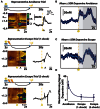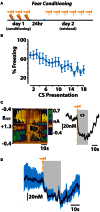On the role of subsecond dopamine release in conditioned avoidance
- PMID: 23759871
- PMCID: PMC3675318
- DOI: 10.3389/fnins.2013.00096
On the role of subsecond dopamine release in conditioned avoidance
Abstract
Using shock avoidance procedures to study conditioned behavioral responses has a rich history within the field of experimental psychology. Such experiments led to the formulation of the general concept of negative reinforcement and specific theories attempting to explain escape and avoidance behavior, or why animals choose to either terminate or prevent the presentation of an aversive event. For example, the two-factor theory of avoidance holds that cues preceding an aversive event begin to evoke conditioned fear responses, and these conditioned fear responses reinforce the instrumental avoidance response. Current neuroscientific advances are providing new perspectives into this historical literature. Due to its well-established role in reinforcement processes and behavioral control, the mesolimbic dopamine system presented itself as a logical starting point in the search for neural correlates of avoidance and escape behavior. We recently demonstrated that phasic dopamine release events are inhibited by stimuli associated with aversive events but increased by stimuli preceding the successful avoidance of the aversive event. The latter observation is inconsistent with the second component of the two-factor theory of avoidance and; therefore, led us propose a new theoretical explanation of conditioned avoidance: (1) fear is initially conditioned to the warning signal and dopamine computes this fear association as a decrease in release, (2) the warning signal, now capable of producing a negative emotional state, suppresses dopamine release and behavior, (3) over repeated trials the warning signal becomes associated with safety rather than fear; dopaminergic neurons already compute safety as an increase in release and begin to encode the warning signal as the earliest predictor of safety (4) the warning signal now promotes conditioned avoidance via dopaminergic modulation of the brain's incentive-motivational circuitry.
Keywords: conditioned avoidance; dopamine; fear conditioning; nucleus accumbens; voltammetry.
Figures



Similar articles
-
Subsecond dopamine release in the nucleus accumbens predicts conditioned punishment and its successful avoidance.J Neurosci. 2012 Oct 17;32(42):14804-8. doi: 10.1523/JNEUROSCI.3087-12.2012. J Neurosci. 2012. PMID: 23077064 Free PMC article.
-
Phasic Dopamine Signals in the Nucleus Accumbens that Cause Active Avoidance Require Endocannabinoid Mobilization in the Midbrain.Curr Biol. 2018 May 7;28(9):1392-1404.e5. doi: 10.1016/j.cub.2018.03.037. Epub 2018 Apr 19. Curr Biol. 2018. PMID: 29681476 Free PMC article.
-
Dopaminergic mechanisms in the conditioned and unconditioned fear as assessed by the two-way avoidance and light switch-off tests.Pharmacol Biochem Behav. 2004 Oct;79(2):359-65. doi: 10.1016/j.pbb.2004.08.006. Pharmacol Biochem Behav. 2004. PMID: 15501313
-
Tales from the dark side: do neuromodulators of drug withdrawal require changes in endocannabinoid tone?Prog Neuropsychopharmacol Biol Psychiatry. 2014 Jul 3;52:17-23. doi: 10.1016/j.pnpbp.2013.07.019. Epub 2013 Aug 1. Prog Neuropsychopharmacol Biol Psychiatry. 2014. PMID: 23911441 Free PMC article. Review.
-
The role of nucleus accumbens dopamine in motivated behavior: a unifying interpretation with special reference to reward-seeking.Brain Res Brain Res Rev. 1999 Dec;31(1):6-41. doi: 10.1016/s0165-0173(99)00023-5. Brain Res Brain Res Rev. 1999. PMID: 10611493 Review.
Cited by
-
Multiple value signals in dopaminergic midbrain and their role in avoidance contexts.Neuroimage. 2016 Jul 15;135:197-203. doi: 10.1016/j.neuroimage.2016.04.062. Epub 2016 Apr 27. Neuroimage. 2016. PMID: 27132047 Free PMC article.
-
Rat behavior and dopamine release are modulated by conspecific distress.Elife. 2018 Nov 28;7:e38090. doi: 10.7554/eLife.38090. Elife. 2018. PMID: 30484770 Free PMC article.
-
Nucleus Accumbens Dopamine Encodes the Trace Period during Appetitive Pavlovian Conditioning.eNeuro. 2025 May 27;12(5):ENEURO.0016-25.2025. doi: 10.1523/ENEURO.0016-25.2025. Print 2025 May. eNeuro. 2025. PMID: 40425363 Free PMC article.
-
Phasic dopamine release in the rat nucleus accumbens predicts approach and avoidance performance.Nat Commun. 2016 Oct 27;7:13154. doi: 10.1038/ncomms13154. Nat Commun. 2016. PMID: 27786172 Free PMC article.
-
Neural signals implicated in the processing of appetitive and aversive events in social and non-social contexts.Front Syst Neurosci. 2022 Aug 3;16:926388. doi: 10.3389/fnsys.2022.926388. eCollection 2022. Front Syst Neurosci. 2022. PMID: 35993086 Free PMC article. Review.
References
-
- Arnt J. (1982). Pharmacological specificity of conditioned avoidance response inhibition in rats: inhibition by neuroleptics and correlation to dopamine receptor blockade. Acta Pharmacol. Toxicol. 51, 321–329 - PubMed
-
- Badrinarayan A., Wescott S. A., Vander Weele C. M., Saunders B. T., Couturier B. E., Maren S., et al. (2012). Aversive stimuli differentially modulate real-time dopamine transmission dynamics within the nucleus accumbens core and shell. J. Neurosci. 32, 15779–15790 10.1523/JNEUROSCI.3557-12.2012 - DOI - PMC - PubMed
-
- Bechterev V. M. (1913). The Psychologie Objective. Paris: Alcan
-
- Bolles R. C. (1972). The avoidance learning problem. Psychol. Learn. Motiv. Adv. Res. Theory 6, 97
LinkOut - more resources
Full Text Sources
Other Literature Sources

